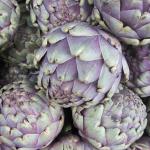Growing Artichokes (Globe)
Cynara scolymus : Asteraceae / the daisy family
| Jan | Feb | Mar | Apr | May | Jun | Jul | Aug | Sep | Oct | Nov | Dec |
|---|---|---|---|---|---|---|---|---|---|---|---|
| S | |||||||||||
| T | |||||||||||
| P |
(Best months for growing Artichokes (Globe) in USA - Zone 5a regions)
- S = Plant undercover in seed trays
- T = Plant out (transplant) seedlings
- P = Sow seed
- Easy to grow. Sow in garden. Sow seed at a depth approximately three times the diameter of the seed. Best planted at soil temperatures between 15°C and 18°C.
- Space plants: 160 - 200 cm apart
- Harvest in 42-57 weeks.
- Compatible with (can grow beside): Needs a lot of space. Best in separate bed
Superthistles growing to 1.2 - 1.3 m high with a spread of 1.2 x 1.2 m.
Very pretty, can be part of a herbacious border.
Harvest from second year. Artichokes grow particularly well in sandy soil. Can be propagated by suckers or offsets. In temperate/warm areas a well fertilised plant will live for about five years and throw up suckers each year. Artichokes aren't hardy enough to overwinter in areas with very cold winters. In cold areas choose a hardy variety from a local supplier and grow it as an annual, with 10 days' exposure to cool daytime temperatures during spring. Transplant only when all danger of frost is past in your area. Aphids and earwigs can be a nuisance.
Culinary hints - cooking and eating Artichokes (Globe)
Pick buds before scales develop brown tips .
If you have lots of small buds, they can be fried in olive oil and eaten whole.
Rinse in plenty of cold water to remove earwigs or other insects.



Your comments and tips